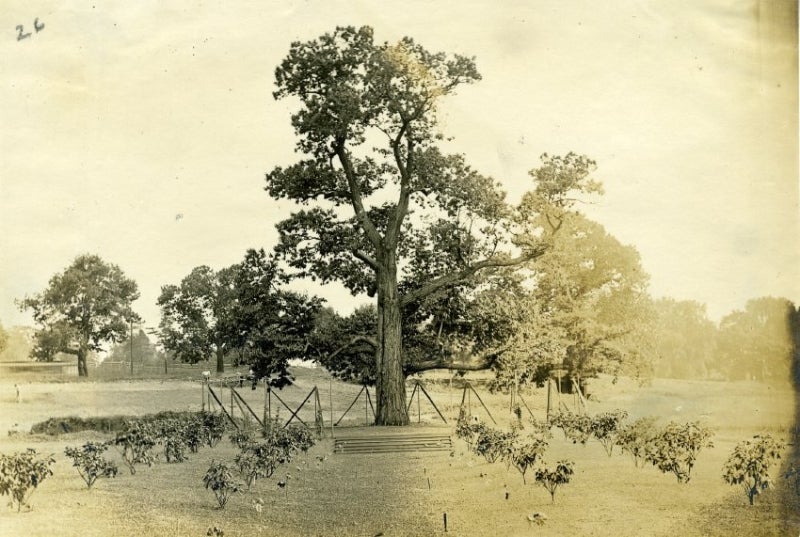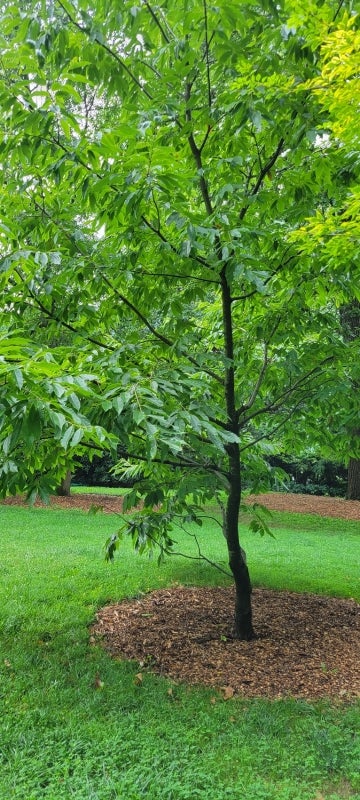Blog


The Chestnut Hill neighborhood in which Morris Arboretum & Gardens resides is named after the magnificent American chestnut (Castanea dentata) that once forested its knolls and slopes. We have photographs of several wizened old trees that graced our grounds prior to 1915, the year the last of our local trees succumbed to chestnut blight.

In fact, tradition has it that Lydia Morris located our Step Fountain near a huge old chestnut as a memorial to her brother John because it was his favorite tree. Sadly, it died a year later. This virulent parasitic fungus (Cryphonectria parasitica) was accidentally imported on Asian chestnuts brought into New York City in 1904 and began to spread like wildfire through native stands. The trees had virtually no immunity to the disease, and by 1940, there were practically no trees left through its native range from Maine to Mississippi. American chestnut was a remarkable tree, and the introduction of this disease was, in my opinion, the worst ecological disaster that has befallen our eastern forests since the arrival of European colonists.
IMPORTANT STAPLE
Chestnut is unusual for several reasons. It is both shade-tolerant and fast-growing, so it could become the dominant tree in both regenerating and old-growth forests. Early summer flowers produce copious quantities of pollen favored by bees and beetles. It produces large crops of highly nutritious nuts every year, unlike oaks, beeches, hickories and pines that might have a large crop only every third or four season. For this reason, it was an important staple for Indigenous peoples as well as myriad mammals and birds. Chestnut wood is very strong and highly decay-resistant, so it was a preferred species for timber framing, siding and fence posts.
I worked for a time at the Connecticut Agricultural Experiment Station, where work was underway on virus-infected (hypovirulent) strains of Cryphonectria. A particular species of mycovirus has become widely established in Europe and has largely controlled the disease in European chestnut (C. sativa). Unfortunately, this approach has not been successful in the US, as a combination of high genetic variability among strains of Cryphonectria and high susceptibility of American chestnut to the disease has made the virus ineffective.

Crossbreeding the American species with blight-resistant Asian chestnuts does confer immunity, but first-generation hybrids are small, spreading trees like their Japanese or Chinese parents. We have several of the original crosses of these growing behind the Horticulture Center, and they are great nut trees but a poor substitute for true American chestnut in other respects. The American Chestnut Foundation has been working on backcrossing these hybrids and is now crossing these resistant seedlings onto American chestnuts. It takes between seven and 10 years for seedlings to flower, but we have a fine example of a sixth-generation seedling growing on the slope above the Dorrance Hamilton Fernery as you exit the Widener Woods. This tree is now 16 years old, 18 feet tall and has begun to flower well. It is visually indistinguishable from American chestnut and has not shown any blight susceptibility to date.
PROMISING RESEARCH
Another promising line of research was pioneered at the State University of New York College of Environmental Science and Forestry in collaboration with the American Chestnut Foundation. In 1990, a gene from wheat was inserted into an American chestnut seedling. This gene produces an enzyme that quickly breaks down oxalic acid—the chemical the fungus uses to kill the tree. This first genetically modified tree—Darling 58—has been making its way through the evaluation and testing process with USDA for 25 years, and it is hoped that the tree will be deregulated, or approved, for release very soon. The Morris is on the list to receive some of the first Darling 58 offspring when they become available so we can test its performance and use it as an educational tool. Should we receive seedlings, we plan to plant one near the Step Fountain in homage to both John Morris and his favorite tree.